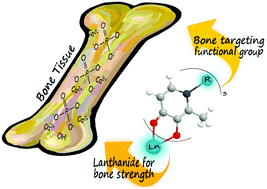In vitro studies of lanthanide complexes for the treatment of osteoporosis†
Abstract
Lanthanide ions, Ln(III), are of interest in the treatment of bone density disorders because they are found to accumulate preferentially in bone (in vivo), have a stimulatory effect on bone formation, and exhibit an inhibitory effect on bone degradation (in vitro), altering the homeostasis of the bone cycle. In an effort to develop an orally active lanthanide drug, a series of 3-hydroxy-4-pyridinone ligands were synthesized and eight of these ligands (H1 = 3-hydroxy-2-methyl-1-(2-hydroxyethyl)-4-pyridinone, H2 = 3-hydroxy-2-methyl-1-(3-hydroxypropyl)-4-pyridinone, H3 = 3-hydroxy-2-methyl-1-(4-hydroxybutyl)-4-pyridinone, H4 = 3-hydroxy-2-methyl-1-(2-hydroxypropyl)-4-pyridinone, H5 = 3-hydroxy-2-methyl-1-(1-hydroxy-3-methylbutan-2-yl)-4-pyridinone, H6 = 3-hydroxy-2-methyl-1-(1-hydroxybutan-2-yl)-4-pyridinone, H7 = 1-carboxymethyl-3-hydroxy-2-methyl-4-pyridinone, H8 = 1-carboxyethyl-3-hydroxy-2-methyl-4-pyridinone) were coordinated to Ln3+ (Ln = La, Eu, Gd, Lu) forming stable tris-ligand complexes (LnL3, L = 1−, 2−, 3−, 4−, 5−, 6−, 7− and 8−). The dissociation (pKan) and metal ligand stability constants (log βn) of the 3-hydroxy-4-pyridinones with La3+ and Gd3+ were determined by potentiometric titrations, which demonstrated that the 3-hydroxy-4-pyridinones form stable tris-ligand complexes with the lanthanide ions. One phosphinate-EDTA derivative (H5XT = bis[[bis(carboxymethyl)amino]methyl]phosphinate) was also synthesized and coordinated to Ln3+ (Ln = La, Eu, Lu), forming the potassium salt of [Ln(XT)]2−. Cytotoxicity assays were carried out in MG-63 cells; all the ligands and metal complexes tested were observed to be non-toxic to this cell line. Studies to investigate the toxicity, cellular uptake and apparent permeability (Papp) of the lanthanide ions were conducted in Caco-2 cells where it was observed that [La(XT)]2− had the greatest cell uptake. Binding affinities of free lanthanide ions (Ln = La, Gd and Lu), metal complexes and free 3-hydroxy-4-pyridinones with the bone mineral hydroxyapatite (HAP) are high, as well as moderate to strong for the free ligand with the bone mineral depending on the functional group.

- This article is part of the themed collection: Chemistry and applications of metal complexes

 Please wait while we load your content...
Please wait while we load your content...